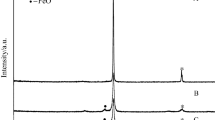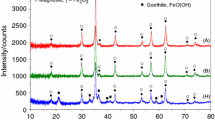Abstract
The oxidation kinetics of ultrafine metallic iron powder to hematite (α-Fe2O3) up to temperatures 800 °C were studied in air using non-isothermal and isothermal thermogravimetric (TG) analysis. The powders with average particles size of 90, 200, and 350 nm were made by the electric explosion of wire. It was observed that the reactivity of the iron powder is increased with the decreasing particle size of powder. The experimental TG curves clearly suggest a multi-step process for the oxidation, and therefore a model-fitting kinetic analysis based on multivariate non-linear regressions was conducted. The complex reaction can be best described with a three-step reaction scheme consisting of two concurrent and one parallel reaction step. In one reaction pathway Fe is oxidized to α-Fe2O3. The other pathway is described by the oxidation of Fe to magnetite (Fe3O4). At higher temperatures the formed Fe3O4 is further oxidized in a α-Fe2O3. It is established that the best fitting three-step mechanism employed a branching set of n-order equations for each step.




Similar content being viewed by others
References
Brown ME, Tribelhorn MJ, Blenkinsop MG. Use of thermomagnetometry in the study of iron-containing pyrotechnic systems. J Therm Anal Calorim. 1993;40:1123–30.
Nazarenko OB, Ilyin AP. Nanopowders production by electrical explosion of wires: environmental applications. In Proceedings of the 3rd Environmental Physics Conference (Aswan, Egypt). 2008:135–40.
Kotov YU, Chang KR, Bagazeyev AV, Beketov IV. Production of copper nanopowders by electric explosion of wire. Study of their oxidation during storage and heating in air. J Metastable Nanocryst Mater. 2003;15–16:343–8.
Burtsev VA, Kalinin KV, Luchinsky AV. Wires electrical explosion and its application in electrophysical plants. Moscow: Energoatomizdat; 1990 (in Russian).
Wen D, Song P, Zhang K, Qian J. Thermal oxidation of iron nanoparticles and its implication for chemical-looping combustion. J Chem Technol Biotechnol. 2011;86:375–80.
Beketov IV, Safronov AP, Medvedev AI, Alonso J, Kurlyandskaya GV, Bhagat SM. Iron oxide nanoparticles fabricated by electric explosion of wire: focus on magnetic nanofluids. AIP Adv. 2012;2:022154. http://dx.doi.org/10.1063/1.4730405.
Chen RY, Yuen WYD. Review of the high-temperature oxidation of iron and carbon steels in air or oxygen. Oxid Met. 2003;59:433–68.
Sanders JP, Gallagher PK. Thermomagnetometric evidence of γ-Fe2O3 as an intermediate in the oxidation of magnetite. Thermochim Acta. 2003;406:241–3.
Opfermann J. Kinetic analysis using multivariate non-linear regression. J Therm Anal Calorim. 2000;60:641–58.
Moukhina E. Determination of kinetic mechanisms for reactions measured with thermoanalytical instruments. J Therm Anal Calorim. 2012;109:1203–14.
Budrugeac P. Application of model-free and multivariate non-linear regression methods for evaluation of the thermo-oxidative endurance of a recent manufactured parchment. J Therm Anal Calorim. 2009;97:443–51.
Surzhikov AP, Frangulyan TS, Ghyngazov SA, Lysenko EN. Investigation of oxidation processes in non-stoichiometric lithium–titanium ferrites using TG analysis. J Therm Anal Calorim. 2010;102:883–7.
Surzhikov AP, Frangulyan TS, Ghyngazov SA, Lysenko EN. Investigation of structural states and oxidation processes in Li0.5Fe2.5O4-δ using TG analysis. J Therm Anal Calorim. 2012;108:1207–12.
Yavorovsky NA, Sedoy VS. Method of obtaining ultrafinely powders. Ru Patent 2359784, 2009.
Yavorovsky NA, Davydovich VI, Bil BA. Apparatus for ultrafine powders manufacturing of inorganic materials by electrical explosion. Ru Patent 2048278, 1995.
Sanders JP, Gallagher PK. Kinetics of the oxidation of magnetite using simultaneous TG/DSC. J Therm Anal Calorim. 2003;72:777–89.
Brown ME, Dollimore D, Gallway AK. Reaction in solid state, comprehensive chemical kinetics. Amsterdam: Elsevier Scientific Publishing Co.; 1980;22:57.
Friedman HL. Kinetics of thermal degradation of char-forming plastics from thermogravimetry. Application to a phenolic plastic. J Polym Sci C. 1964;6:183–95.
Campo L, Perez-Saez RB, Tello MJ. Iron oxidation kinetics study by using infrared spectral emissivity measurements below 570 °C. J Corros Sci. 2008;50:194–9.
Acknowledgements
This work was supported by The Ministry of Education and Science of the Russian Federation in part of the “Science” program.
Author information
Authors and Affiliations
Corresponding author
Rights and permissions
About this article
Cite this article
Lysenko, E.N., Surzhikov, A.P., Zhuravkov, S.P. et al. The oxidation kinetics study of ultrafine iron powders by thermogravimetric analysis. J Therm Anal Calorim 115, 1447–1452 (2014). https://doi.org/10.1007/s10973-013-3456-x
Received:
Accepted:
Published:
Issue Date:
DOI: https://doi.org/10.1007/s10973-013-3456-x




